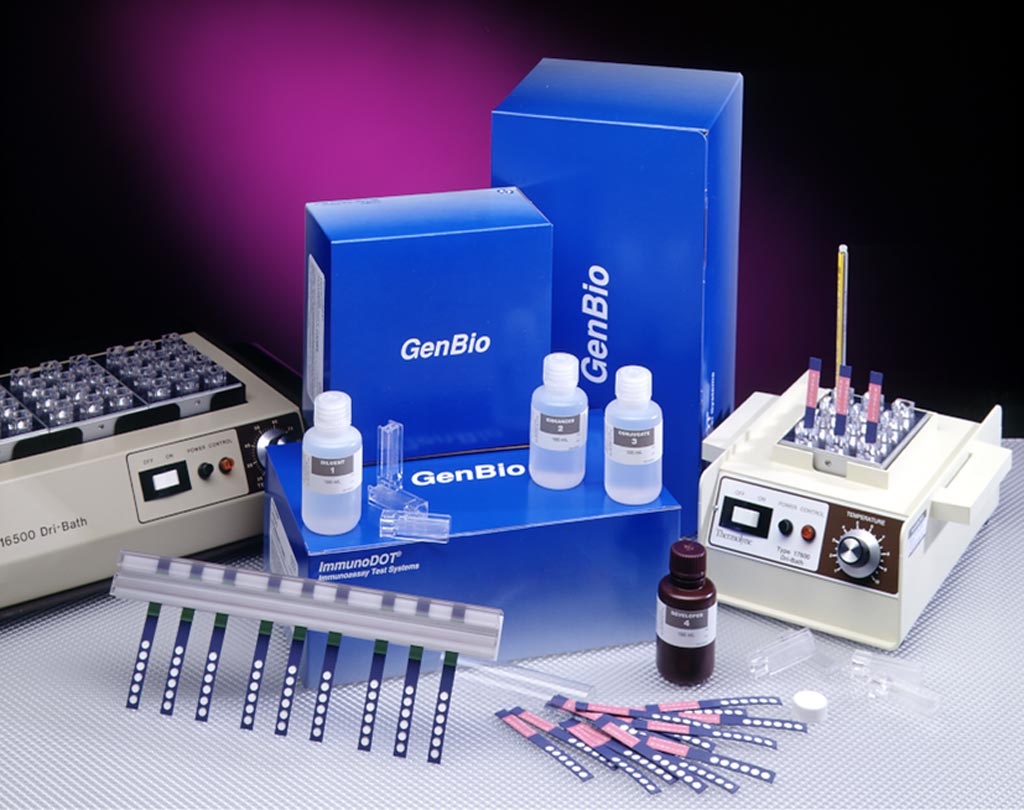Assays Evaluated for Early Diagnosis of Leptospirosis
By LabMedica International staff writers
Posted on 11 Jul 2017
Leptospirosis is a potentially life-threatening but curable zoonosis whose prognosis depends on accurate and timely diagnosis and because of its non-specific clinical presentation, laboratory testing is essential to confirm the diagnosis.Posted on 11 Jul 2017
Leptospirosis is caused by pathogenic spirochetes of the genus Leptospira. With an estimated 1.03 million cases and 58,900 deaths occurring each year, leptospirosis represents a major threat to public health worldwide. Severity ranges from relatively mild flu-like symptoms to Weil’s syndrome, a severe and potentially life-threatening form of the disease characterized by multiple organ failure, including the liver, kidneys, lungs, heart and brain.

Image: The ImmunoDOT is a proprietary dotblot method reporting a semi-quantitative IgM titer for leptospirosis (Photo courtesy of GenBio).
Microbiologists at the University Hospital of Fort-de-France (Martinique, French West Indies) and their colleagues conducted a retrospective study between January 2011 and December 2012 of a total of 122 patients were diagnosed with leptospirosis, as confirmed by quantitative polymerase chain reaction (qPCR). Among them, 103 had at least one serum sample available for analysis. Performance of each serological assay was evaluated according to days' post onset of symptoms (DPO) and local species diversity.
Blood plasma samples were collected in ethylenediaminetetraacetic acid (EDTA) tubes obtained from patients with clinically suspected leptospirosis. Serum specimens were collected in plastic red-top tubes at different times during the course of the illness and stored at -20 °C until testing. The team assessed the performance of two enzyme-linked immunosorbent assays (ELISAs): ELISA Serion and ELISA-Hb Pasteur and one immunodot using qPCR as the gold standard.
The scientists reported the sensitivity of ELISA Serion, ELISA-Hb Pasteur and GenBio immunodot was 75%, 67% and 64%, while specificity was 92%, 98% and 100%, respectively. Moreover, the threshold optimization allowed a significant improvement in specificity for the ELISA Serion from 92% to 99%. During the first five DPO, sensitivities were 35%, 30% and 42% for ELISA Serion, ELISA-Hb Pasteur and GenBio immunodot, respectively. However, between six to 10 DPO, these sensitivities dramatically increased to reach 86%, 76% and 67%, respectively. Performances of the three assays were not affected by the species studied.
The authors concluded that all the serological assays evaluated showed the potential for diagnosing leptospirosis after, but not before six days’ post onset of symptoms. In a high prevalence setting, where highest specificities are needed, threshold optimizing should be performed for this purpose. The combination of serology and qPCR could be the most reliable approach for laboratory confirmation of clinically suspected cases of leptospirosis in resource-limited settings, easy handling and cost-effectiveness may be the main decision factors to choose between assays with similar accuracy for routine use. The study was published on June 23, 2017, in the journal Public Library of Science Neglected Tropical Diseases.
Related Links:
University Hospital of Fort-de-France














